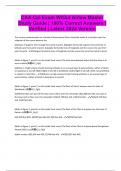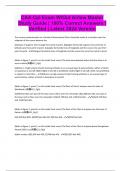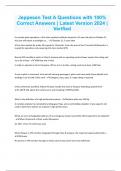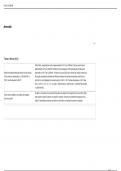What is an isogonic line - Study guides, Class notes & Summaries
Looking for the best study guides, study notes and summaries about What is an isogonic line? On this page you'll find 15 study documents about What is an isogonic line.
Page 2 out of 15 results
Sort by

-
CPL Practice Exam 3 Questions and Answers Latest 2024
- Exam (elaborations) • 6 pages • 2024
-
- $14.79
- + learn more
CPL Practice Exam 3 A broken magneto grounding wire would be indicated by - Answer-no RPM drop during the mag check or the engine continuing to run when OFF is selected. A commercial or airline transport licenced pilot is required to have a valid pilot certificate in possession when - Answer-acting as a flight crew member. A commercial pilot flying a single-engine aircraft VFR in an air taxi operation while carrying passengers at night must have - Answer-a pilot proficiency check. A ...

-
CAA Cpl Exam W/Out Airlaw Master Study Guide | 100% Correct Answers | Verified | Latest 2024 Version
- Exam (elaborations) • 258 pages • 2024
-
- $15.23
- + learn more
CAA Cpl Exam W/Out Airlaw Master Study Guide | 100% Correct Answers | Verified | Latest 2024 Version True course measurements on a Sectional Aeronautical Chart should be made at a meridian near the midpoint of the course because the (A)values of isogonic lines change from point to point. (B)angles formed by isogonic lines and lines of latitude vary from point to point. (C)angles formed by lines of longitude and the course line vary from point to point - (C)angles formed by lines of lo...

-
CAA Cpl Exam W/Out Airlaw Master Study Guide | 100% Correct Answers | Verified | Latest 2024 Version
- Exam (elaborations) • 258 pages • 2024
-
- $25.49
- + learn more
True course measurements on a Sectional Aeronautical Chart should be made at a meridian near the midpoint of the course because the (A)values of isogonic lines change from point to point. (B)angles formed by isogonic lines and lines of latitude vary from point to point. (C)angles formed by lines of longitude and the course line vary from point to point - (C)angles formed by lines of longitude and the course line vary from point to point (Refer to figure 1, point 9, on the inside front cover...

-
Jeppesen Test A Questions with 100% Correct Answers Latest Version 2024 Verified
- Exam (elaborations) • 39 pages • 2024
-
- $8.99
- + learn more
For private pilot operations, a first class medical certificate issued to a 23 year old pilot on October 21, this year will expire at midnight on... - October 31, 5 years later A first class medical for under 40 is good for 12months. From the start of the 13 month till 60months, it is good for operations only requiring 3rd class medical (PP) Normal VFR conditions exists in Class D airspace with an operating control tower require the ceiling and vis to be at least - 1000 feet and 3 miles In...

-
Jeremiah Terms in this set (143) What is the approximate base of the cumulus clouds if the surface air temperature at 1,000 feet MSL is 70°F and the dewpoint is 48°F? When lifted, unsaturated air cools at approximately 5.4°F per 1,000 fee
- Exam (elaborations) • 11 pages • 2024
- Available in package deal
-
- $7.99
- + learn more
Jeremiah Terms in this set (143) What is the approximate base of the cumulus clouds if the surface air temperature at 1,000 feet MSL is 70°F and the dewpoint is 48°F? When lifted, unsaturated air cools at approximately 5.4°F per 1,000 feet. The dew point cools at approximately 1°F per 1,000 feet. Therefore, the convergence of the temperature and dew point lapse rates is 4.4°F per 1,000 feet. The base of a cloud (AGL) that is formed by vertical currents can be ...

Do you wonder why so many students wear nice clothes, have money to spare and enjoy tons of free time? Well, they sell on Stuvia! Imagine your study notes being downloaded a dozen times for $15 each. Every. Single. Day. Discover all about earning on Stuvia


